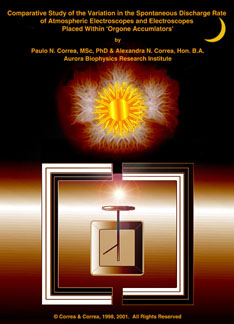![Akronos logo]](/images/akronos_wheel.jpg)
|
Akronos Publishing Concord, ON, Canada www.aetherometry.com |
![Akronos logo]](/images/akronos_wheel.jpg)
|
Akronos Publishing Concord, ON, Canada www.aetherometry.com |

Comparative study of the variation in the spontaneous discharge rate
of atmospheric electroscopes and electroscopes placed within
'orgone accumulators'
by Correa, Paulo N. & Correa, Alexandra N.
Published in July 2001. 81 pages.
Series: Experimental Aetherometry, Vol. 1
Monograph AS2-06
Price: US $25 ($20 ISFA)
This monograph is also included in the print edition of Experimental Aetherometry, Vol. 1
|
ABSTRACT
We have previously demonstrated the existence of a nonelectric regenerative phenomenon at the electroscope. Independently from its responses to electric and ionizing radiative fields, the electroscope also responds to a nonelectric, nonionizing hidden variable in the local medium capable of replenishing the kinetic energy, which charges, when trapped in a conductor and undergoing electric repulsion, spend to perform the antigravitational work of deflecting the electroscopic leaf. We have previously shown how this local hidden variable is responsible for the observed deceleration or arrest of the spontaneous discharge of electroscopes. Subsequently, we showed how the same local variable is fed by a nonlocal hidden variable sourced in solar radiation. In the preceding paper we then demonstrated how the thermal anomaly discovered by W. Reich inside Orgone Accumulators (ORACs) and central to the controversial Reich-Einstein experiment, cannot be accounted for by the blackbody absorption spectrum of these devices, and raises therefore the question of how thermal energy is locally converted from a nonelectromagnetic medium energy. In the present communication, we present evidence for the fact that the energy concentrated inside ORACs and responsible for the anomalous deceleration and arrest of electroscopes placed within them, irrespective of charge polarity, is neither thermal nor electric. The proposed methodology allows us for the first time to determine the comprehensive values of the energy and power of ORAC devices (in Reich's idiom, to measure the actual orgone energy values, and their variation, within these devices), and as well to establish that the electroscopic kinetoregenerative phenomenon is not a thermal one. We close the presentation by suggesting that the Aether energy effect responsible for the thermal and electroscopic anomalies observed within the ORAC is neither electric, nor electromagnetic, nor gravitational per se, but antigravitational. In full agreement with our Aetherometric Theory of Synchronicity (AToS), we conclude that, by a heretofore unknown process, charges trapped in a conductor undergoing electrostatic repulsion - or, for that matter, in a dielectric undergoing electrostatic repulsion, as can be easily observed with electroscopic leaves made of dielectric materials - and subject to a local gravitational potential, are able to tap local Aether energy and to convert some of its nonelectric and nonelectromagnetic energy into their kinetic energy. This kinetic energy is associated with charge but distinct from it, and charge spends it precisely to counteract the continuous action of the local gravitational energy. This counteraction is maximal at electroscopic discharge arrest. The kinetoregenerative phenomenon demonstrates therefore that there exists another form of energy which is neither electric, nor electromagnetic, nor gravitational. Yet, this energy appears to be responsible for an array of electric, thermal and gravitational anomalies. |